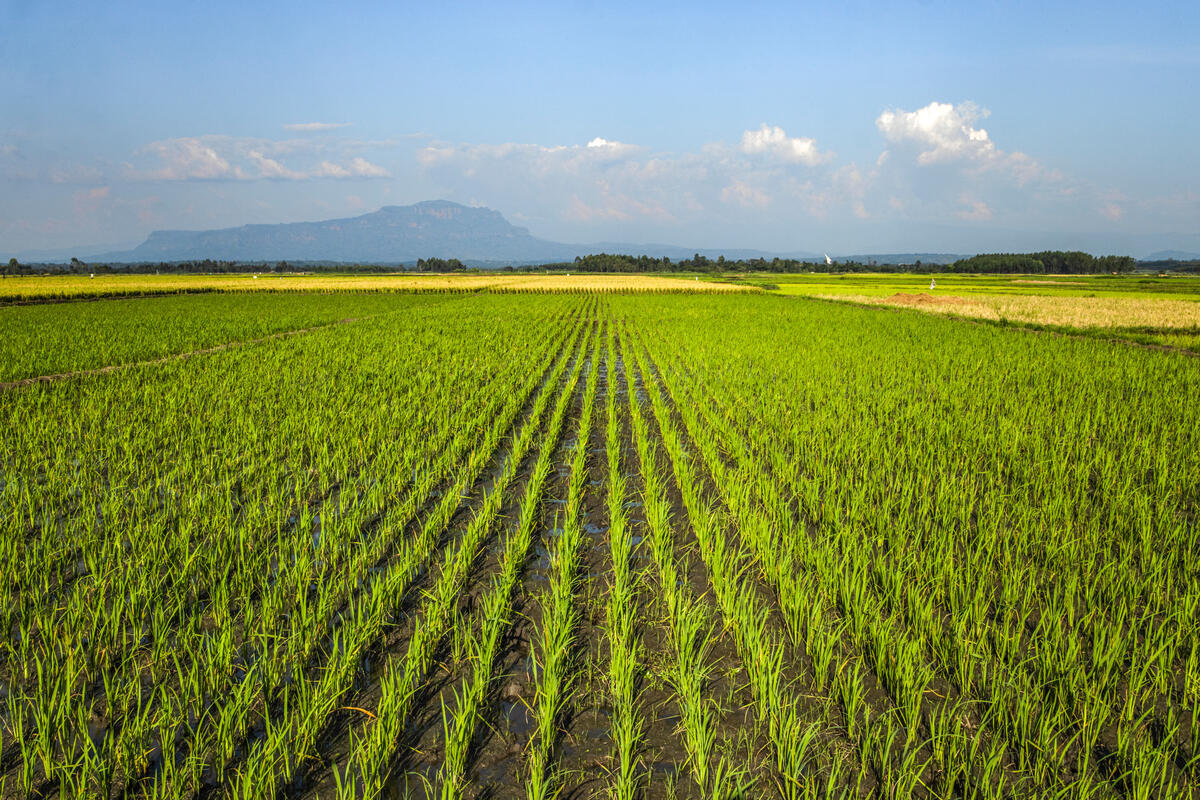November 27, 2025 | 18:50 GMT +7
November 27, 2025 | 18:50 GMT +7
Hotline: 0913.378.918
November 27, 2025 | 18:50 GMT +7
Hotline: 0913.378.918

Rice growing in Uganda.
The FAO Food Price Index, a benchmark of world food commodity price developments, remained largely unchanged in March from its revised February value, as declines in world cereal and sugar quotations offset a notable increase in vegetable oil prices, the Food and Agriculture Organization of the United Nations (FAO) reported on Friday.
The index, which tracks monthly changes in the international prices of a set of globally traded food commodities, averaged 127.1 points in March, 6.9 percent higher than its corresponding level one year ago but remaining 20.7 percent below its March 2022 peak.
The FAO Cereal Price Index declined by 2.6 percent in March and was down 1.1 percent from March 2024. Global wheat prices dropped as concerns over crop conditions in some major Northern Hemisphere exporters eased, though currency movements tempered the decline. World maize prices also decreased from February, as did those for sorghum. The FAO All-Rice Price Index declined by 1.7 percent amid weak import demand and ample exportable supplies.
By contrast, the FAO Vegetable Oil Price Index increased by 3.7 percent from February to average 23.9 percent higher than its year-earlier level. Quotations for palm, soy, rapeseed and sunflower oils all rose, driven by robust global import demand.
The FAO Meat Price Index also rose, increasing by 0.9 percent on the month and 2.7 percent on the year, primarily due to higher pig meat prices in Europe after Germany regained foot-and-mouth-disease-free status and the strengthening of the euro against the United States dollar. World poultry meat prices remained largely stable in March, despite the continued challenges posed by widespread avian influenza outbreaks in some major producing countries.
The FAO Dairy Price Index was unchanged from February, with lower international cheese prices offset by higher quotations for butter and milk powders.
The FAO Sugar Price Index dropped by 1.6 percent in March, mainly driven by signs of weaker global demand. Recent rainfall in key sugarcane growing areas of southern Brazil further contributed to the decline, while deteriorating production prospects in India and continuing concerns about the overall outlook for the crop in Brazil limited the price decline.
Updated forecasts for cereal supply and demand
FAO also released a new Cereal Supply and Demand Brief on Friday, with revised estimates for 2024 and fresh insights on cropping and crop prospects in 2025.
The estimate for global cereal production in 2024 stood at 2 849 million tonnes, representing a 0.3 percent year-on-year drop but higher than previous estimates due to larger-than-previously-anticipated wheat outturns in Australia and Kazakhstan. FAO’s world rice production forecast for 2024/25 is little changed at 543.3 million tonnes, implying a 1.6 percent yearly increase due mostly to expanded plantings.
FAO’s forecast for global wheat production in 2025 remains unchanged from last month at 795 million tonnes, on par with the revised estimate for 2024. Wheat output in the European Union is expected to expand by 12 percent, following weather-induced declines in 2024, and is also likely to increase in Argentina, Egypt and India, while to decline in Australia, the United States of America and swathes of Near East Asia.
Maize harvests in the southern hemisphere are set to vary, with increases expected in Brazil and South Africa but a decline in Argentina.The new FAO forecast for world cereal utilization in 2024/25 stands at 2 868 million tonnes, representing a 0.9 percent increase from the 2023/24 level, led primarily by a new record-high level of rice utilization.
World cereal stocks are predicted to decline by 1.5 percent to 873.3 million tonnes by the close of seasons in 2025, driven mainly by an anticipated significant contraction in coarse grain stocks. By contrast, global wheat and rice inventories are expected to increase.
The updated forecasts place the world cereal stocks-to-use ratio in 2024/25 at 30.1 percent, slightly down from the previous year but still indicating an overall comfortable level, FAO said.
FAO has further lowered its forecast for world cereal trade in 2024/25 by 5.3 million tonnes to 478.9 million tonnes, marking a 6.7 percent contraction from 2023/24 and the lowest level since 2019/20. Lower expected purchases by China are a primary driver of the lower trade forecasts for coarse grains and wheat.
(FAO)
/2025/11/24/3616-2-141832_513.jpg)
(VAN) FSC certification has helped increase the value of thousands of hectares of planted forest timber under the management of the Xuan Loc Protection Forest Management Board, particularly in terms of selling prices.

(VAN) More than 100 shoppers queued for a chance to get a kilo or so of Japanese rice for 500 yen ($3.32) by heaping as much grain into a small wooden box as possible.

(VAN) Benchmark international prices of milled declined in October as harvests started or improved in some parts of the globe.

(VAN) Show cause orders will be issued to retailers who sell imported rice at prices exceeding the maximum suggested retail price (MSRP) of P43 per kilo, Philippines Agriculture Secretary said in a statement on Thursday.

(VAN) Coffee prices on October 20, 2025, remained stable domestically, trading at 113,500–114,500 VND/kg. Similarly, global coffee prices also moved sideways.

(VAN) By October, Vietnam’s coffee exports had surpassed USD 7 billion for the first time and will exceed USD 8 billion within this year.

(VAN) Illinois rancher says Texas, Oklahoma, Kansas lost grass and forage, forcing massive cattle liquidation.